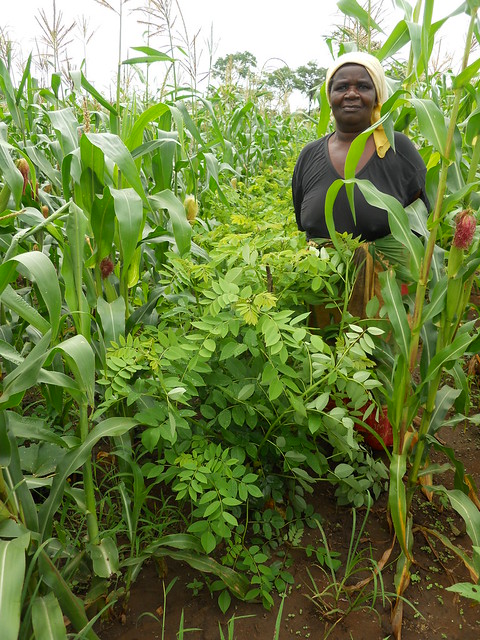Addressing smallholder farmers’ needs with green manure cover crops and agroforestry in Zambia

In Africa, mineral fertilizer remains a scarce, expensive, and risky resource for most smallholder farmers. On average, farmers use less than 10 kg/ha of NPK fertilizer; and many do not apply it at all. The price of fertilizer is 3-5 times higher in Africa than in Europe due to the lack of infrastructure and production facilities, often making it unaffordable and sometimes inaccessible to farmers. Fertilizer is primarily applied to higher value and horticulture crops that, unlike maize, give farmers a greater return on their investment.
Farmers in southern Africa plant maize extensively on large areas, harvest less than 2 t/ha on average, extracting already depleted nutrients from the soil while trying to become food secure and escape from poverty―an impossible task!
In Eastern Province of Zambia, farmers are being offered a range of solutions by Africa RISING that provide a way out of this poverty trap. These technologies, options, and approaches include drought- and stress-tolerant maize germplasm, conservation agriculture (CA), improved rotation and intercropping with grain legumes, agroforestry, and green manure cover crops.
The use of CA principles (minimum soil disturbance, crop residue retention, and diversification through rotation and intercropping) hinges on the ability of farmers to retain sufficient surface crop residues to protect the soil from erosion, runoff, evaporation, and excessive temperatures. However, farmers in mixed crop-livestock systems face competing demands for these residues because they also feed them to their animals. Green manure and selected agroforestry species are therefore grown to improve the soil, generate biomass for ground cover, and provide fodder; some also produce high protein grain for food, feed, or for sale on the market.
For the past six cropping seasons, CIMMYT and its partners have tested a range of species. Crops such as velvet bean, lablab, cowpea, sunnhemp, jack bean, pigeonpea, and Gliricidia, have been identified as viable options with great potential for smallholders. In some cases, they can provide 5-50 t/ha of extra biomass for groundcover and/or fodder, leave up to 350 kg/ha of residual nitrogen in the soil and in most cases, do not need extra fertilizer to grow.
The Africa RISING project is testing these species, in full rotation or intercropped with maize, on farmers’ fields and on-station to identify the best possible options and arrangements. “We mostly like cowpea, pigeonpea, and lablab, because they provide grain and soil improvement at the same time. We are not sure yet about jack bean although we have seen that maize that is grown after jack bean has higher yields,” Mr Paul Mbau from Chiparamba said. To increase adoption, the project is using an intensive participatory process to adapt the green manure to the needs and conditions of smallholder farmers.
On project sites managed and implemented by our project partner CRS, farmers discovered that maize intercropped with green manure has other benefits. Mr Shadreck Sakala from Samuel Camp in Chipata highlighted: “Both of the plots where maize was intercropped with cowpea and lablab did much better in the dry spell and they only needed one weeding as compared with two or three on other plots”.
COMACO, another partner under Africa RISING has gained long-term experience of up to 5 years with a maize-Gliricidia intercropping system, which is now being tested to better understand the dynamics and yield effects of this promising intercropping system on maize. CIMMYT and its partners CRS, TLC, COMACO, and Grassroots Trust will further explore new ways of integrating green manure into smallholder farming systems so it becomes the status quo, not just an option!
By Christian Thierfelder and Sebastian Scott
Originally produced in August 2016




